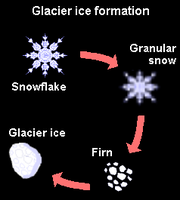How Glaciers Form
A glacier forms when the accumulation of snow and ice exceeds its overall loss of mass, called ablation. As the snow accumulates, it is subject to repeated freezing and thawing. This process turns the snow into granular ice. As the ice is compacted by new layers of snow, the volume decreases and the density increases, gradually turning into firn. Over long periods of time, as the overlying weight increases, more compaction and recrystallization occurs, which leads to the formation of glacial ice.

http://nethelper.com/article/Glacier
Mass Balance of a Glacier
A glacier can be divided into two zones; the zone of accumulation and the zone of ablation. The zone of accumulation is the upper part of the glacier where most of the snowfall is received, causing its net accumulation of mass. Ablation includes both melting and sublimation of ice to cause a net loss of mass. The equilibrium line lies between these two zones and is the boundary where the amount of accumulation is equal to the amount lost by ablation.
http://www.eoearth.org/article/Glacier?topic=54335
The mass balance of a glacier determines the position of the glacier's terminus. When accumulation is greater than ablation, the terminus will advance. When ablation is greater, the terminus retreats. Therefore a stable terminus indicates exact balance between accumulation and ablation.
